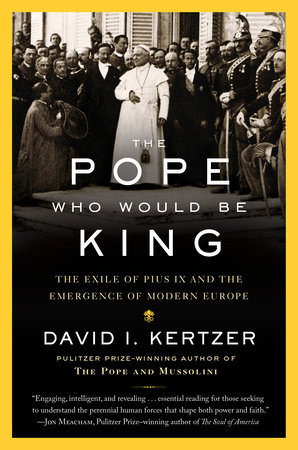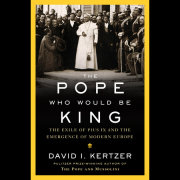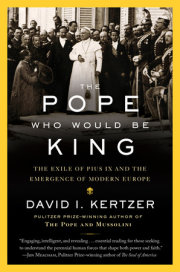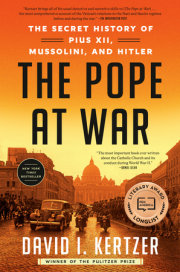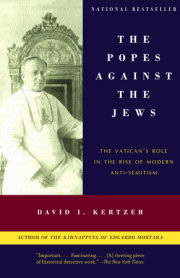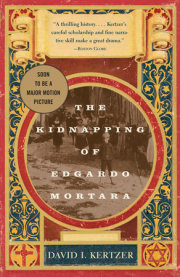Chapter 1
The Conclave
It would have been a great surprise to the cardinals who elected the rather unassuming Giovanni Mastai Ferretti to be pope in 1846 to learn that he would become the most important pontiff of modern times. In the revolutionary fervor that swept mid-nineteenth-century Europe, he was first hailed in Italy as a national hero, a savior, praised in thousands of hymns and poems. But with sickening speed, the cries of joy turned into shouts of “traitor” and even calls for the pope’s death. These were times of transformation in Europe, the old order unhinged by industrialization, revolutionary advances in transportation, and increasing doubts about the divinely ordained social order. Pius IX would face these dizzying changes with a sense of alarm and, increasingly, with a frightening feeling of losing control. He was a man with benevolent instincts and deep faith but woefully limited ability to understand the larger forces that were transforming the world. Out of Pio Nono’s desperation, the modern Roman Catholic Church was formed.
He would be the last of the pope-kings, a dual role central to church doctrine and a pillar of Europe’s political order for a thousand years. The demise of the pope’s kingdom on earth would mark a pivotal moment in the transformation of Europe, a revolution begun over a century earlier with the spread of radical notions of consent of the governed and separation of church and state. Such a fateful change would not come easily, nor without the shedding of much blood.
The revolutions that swept Europe in 1848 marked the beginning of the end for the aristocratic regimes that had ruled much of the continent for centuries. While many would survive the year, and their rattled rulers would be able to return to their capitals, they would never be the same. The days of divine rule and imperial dynasty were numbered, for the people from Palermo to Venice, from Paris to Vienna, had briefly, intoxicatingly, glimpsed a very different kind of life—the life not of subjects but of empowered citizens.
Nowhere were these epochal changes more dramatic than in Rome, the Eternal City, capital of the Papal States. Nowhere was the divine right to rule more firmly established. And nowhere did local events have greater international resonance, as millions of Catholics on both sides of the Atlantic anxiously followed reports of the fall of the pope and his flight to precarious exile. Not a few predicted that the end of the papacy was near.
Pius IX’s predecessor, Gregory XVI, had not been an attractive man. An ascetic monk, born to a family of local nobility in Lombardy, in northern Italy, he had a colossal nose, and his mouth turned downward in a permanent frown. The removal of a malignant tumor from his face had made things worse, leaving an ugly scar. Gregory had a well-earned reputation as a foe of all that was new. Opposed to allowing railroads in his kingdom, he had also forbidden his subjects from taking part in the scientific congresses that were multiplying throughout Europe at the time. Ruling as he saw fit over the corrupt and ill-governed Papal States, the pope did not seem unduly bothered by the hostility of his three million subjects.
Poverty engulfed the countryside, but the sumptuous sixteenth- and seventeenth-century palaces of aristocrats and cardinals provided work for many of the people of Rome. Romans made little distinction between the two, for cardinals were typically younger sons of the nobility, the older inheriting the father’s title and property. For centuries, the popes themselves had often been drawn from these same families.
Despite the wealth of its aristocrats, the splendor of their frescoed palaces, and the magnificence of many of the city’s churches, the capital of Christendom was a rather shabby sight. Nearly half the land inside the city’s wall consisted of abandoned fields. Scattered amid the occasional cluster of umbrella pine trees and modest vineyards lay the sun-bleached ruins of ancient thermal baths, aqueducts, and churches. Snaking through the city, the Tiber River divided the smaller right side—consisting of the Vatican’s palaces to the north and Trastevere’s humble dwellings to the south—from the larger left side, site of the city’s major monuments and ancient ruins. Along the riverbanks, green-cloaked shepherds looked on as their goats chewed the grass and drank from the river’s fetid yellow waters. When it rained, mud oozed over the city’s broken cobblestone streets and made walking, and even travel in carriages, hazardous. “You have to get used to Rome,” observed the visiting Russian writer and social reformer Alexander Herzen, adding, “its good sides are not obvious. There is something senile, obsolete, deserted and dilapidated in the city’s exterior; its melancholy streets, its gloomy palaces.”
The cramped, dank apartments of the poor had no stoves, so people made their cooking fires outside, sending the pungent odor of boiled broccoli wafting through the streets. “The cat is here esteemed a delicacy among the lower classes,” recalled the American sculptor William Wetmore Story, “and if you happen to own a particularly large and fat one, you must keep a sharp look out, or you will lose it.”
An open-air meat market radiated from the ancient Pantheon through a tangle of winding narrow streets that bustled with activity. Wires hung down from the buildings, allowing women to lift buckets of fresh water from the street up into their apartments. Meats hung from the awnings of the butchers’ booths, and a hodgepodge of goods was displayed atop their counters. Detracting from what might otherwise have been an appetizing scene was the stench from the refuse, dust, feathers, and foul waters that covered the ground. Forcing their way through the crowded streets, butchers in blood-spattered smocks drove carts weighed down by cattle slaughtered at the city’s edge. The butchers dispatched the smaller animals—goats, sheep, and pigs—outside their shops. Chickens, turkeys, ducks, and geese cackled in their pens, while men and women sat nearby plucking the fowl and cramming their feathers into large baskets. As they finished each bird, they blew into its beak, inflating the creature’s body to grotesque size before hanging it on a hook for sale.
On Wednesdays and Saturdays, the huge, oblong Piazza Navona hosted Rome’s main fruit and vegetable market, where customers elbowed their way through the crowds, inspecting whatever was in season. Mushrooms received special attention, for over the years poisonous varieties had caused the death of more than one cardinal, along with many lesser Romans. Now, before any bag of mushrooms could be sold, a Roman official had to give it his stamp of approval.
Barbers, too, were found everywhere in Rome, plying their trade in the open air. When a customer sat down for a shave, the barber sharpened his blade with a great flourish, using the leather strap that hung from the back of the chair, and then accomplished his task with surprising speed. The next customer, suffering from a toothache, might have her tooth pulled or, if feeling unwell, be bled.
But what most struck the visitor to the Eternal City was neither the markets nor the swarms of beggars—both common enough in other cities of Europe—but the omnipresence of churches and priests. Rome, a city of 170,000, had almost four hundred churches, most richly adorned. It could claim thirty-five hundred priests and monks, along with fifteen hundred mostly cloistered nuns. The clergy could not have been a more varied lot. Many members of the mendicant religious orders were almost indistinguishable from the other foul-smelling, poorly clad men who accosted passersby for handouts. By contrast, the upper clergy were the princes of the church. Living in splendor, they held all the highest government positions and controlled the best farmland, producing half of all the agricultural wealth of the Papal States, yet paying no taxes. The prelates administered the public treasury, which they regarded as the property not of the public but of the church. They were also in charge of all the schools, the courts, and the police. “A cardinal,” observed the French ambassador, “is a prince in Rome, and a lord in the provinces.”
The lower clergy—priests, monks, friars, and nuns—were another matter. For the most part, they were from humble families, were poorly educated, and—especially in rural areas—lived in poverty themselves. The parish priests in the capital were an exception, for they enjoyed some of the power that came from the marriage of religious and civil authority. When they encountered a parish priest in the streets of Rome, men doffed their hats, women and children kissed his hand. These priests felt free to enter any home in their parish at any hour to see if church precepts were being obeyed. They employed spies and ordered police to search homes, make arrests, and haul offenders to the city’s dungeons. When those jailed were brought to court, often after some months, they came before judges who themselves were priests. There the parish priest’s testimony was treated as gospel. Romans could be charged with having adulterous relations or practicing sodomy, or for swearing, or for failing to observe the ban on eating meat during Lent. All this, of course, did not endear the clergy to the people nor make them eager to support the continuation of what they called “priestly rule.”
The parish priests cut a distinctive figure on the streets of Rome, with their fuzzy black three-corner hats, the brim folded up on the sides to form a kind of heavy umbrella atop the cleric’s head. They wore black shoes with prominent buckles, short black pants that left their calves bare, and a black gown that extended to their knees and buttoned down to their stomach. For additional effect, many carried a walking stick, capped by a shiny metal knob. But these priests were the elite of the lower clergy. The others—simple priests and monks—viewed the upper clergy with envy. They were the clergy’s proletariat, as resentful of the wealth and power of the church elite as were the laypeople of the Papal States.
As cardinals rode in carriages of unmatched luxury through the streets, they passed beggars who seemed to be everywhere: at every corner, every piazza, every monument, at the entrance of the churches, and pleading for handouts in the cafés. “Nothing,” observed a French visitor, “equals the cynicism and the audacity of the Roman beggar. It is not a favor that he asks, it is a right that he exercises and, as he always asks in the name of the Madonna, or for the most sacred sacrament, or for the souls in purgatory, while he kisses the image of the Virgin that adorns the collection box that he holds in his hand, he offers you the chance to do a pious deed, and so considers you to be indebted to him.”
Yet while the people of Rome resented the power of their parish priest and the cardinals’ ostentatious wealth, they were certainly religious in their own way. Every home and every shop had an image of the Madonna, beneath which at least one lamp always burned. Each family had a particular saint to whom it was devoted, and each household head belonged to a religious confraternity. “The Romans,” wrote a French observer of the time, “follow the practices of devotion from habit, from fear of hell, and from fear of their parish priest.” They will cheat a foreigner without scruple, he added, or knife a neighbor in a moment of anger, “but to miss Sunday mass, to fail to do the least thing due on the saint’s day, or to eat meat on Friday, never.”
While popes had ruled the Papal States for over a thousand years, the extent of their territories had ebbed and flowed, as they engaged in both military campaigns and diplomatic maneuvering to enlarge their realm. In Gregory’s day it extended from Ferrara and Bologna in the north, running southeast around the Grand Duchy of Tuscany to encompass a long stretch of the Adriatic coast including the port of Ancona. From the Tyrrhenian Sea on Italy’s western coast, south of Tuscany, the pope’s lands reached down past Rome to encompass a series of smaller towns. To the north, the Papal States bordered the Austrian kingdom of Lombardy-Veneto, to the south the Kingdom of Naples. In all, the Papal States encompassed only 14 percent of the land of what is Italy today, but it lay right in the center of the peninsula. Most of its three million largely illiterate inhabitants were peasants, eking a living from the land.
The technical innovations that were transforming life farther north in Europe had made little headway in the Papal States. There were few factories and no trains. But this backwardness was deceptive. The old verities on which the pope’s rule rested had been under attack for several decades. In the wake of the French Revolution and the subsequent spread of its doctrines by Napoleon and the French army, people began to question the notion that God had ordained the social hierarchy to be as it was. Increasingly they resented the prerogatives of both clergy and aristocracy. According to the ideology of divine right, kings were chosen not by men but by God, and so any attempt to overthrow the monarch was a sacrilege, an offense against the Almighty. But a new, subversive theory of government was spreading. Sovereignty, in this way of thinking, lay not with the ruler but with the people. A pope-king, wielding an army and a police force, increasingly came to be viewed as a vestige of the Middle Ages. While the pontiff was properly the Holy Father of the Catholic faithful worldwide, he seemed to many to have no business also serving as a king. Nor, they thought, did priests have any business running the police and the courts.
Sweeping through Europe together with these Enlightenment-fueled ideas was another powerful new doctrine, nationalism. The Italian Peninsula at the time was divided into a multitude of different states, a patchwork of kingdoms, imperial outposts, and duchies. Many were ruled directly or indirectly by the Austrian Empire. As the growing number of nationalists saw it, all of Italy should be united. Foreign armies and foreign rulers had no place there.
Although Pope Gregory was far from a young man, his death came as something of a surprise, for he had not been ill. In late May 1846, what first appeared to be simply an irritating inflammation and swelling of his left leg quickly turned into something worse. He died on the morning of June 1.
For centuries the death of a pope had triggered not only frenetic jockeying for influence among the elite but often violent popular unrest as well. Gregory XVI himself had been elected fifteen years earlier amid signs of imminent revolt in his realm. News of an uprising in Bologna, the second city of the Papal States, reached Rome in the middle of Gregory’s coronation ceremonies. Soon the whole northern region of the Papal States was in flames as one city after another declared the end of papal rule. It was only thanks to the swift arrival of Austrian troops that the old order was restored. Now, a decade and a half later, the theocracy seemed no more stable. Cardinals still headed the government’s major departments, and under them a network of bishops, priests, and monks still held all the most influential governmental positions, monopolized education, and sat as judges in courts that made little distinction between religious and civil matters. Gregory’s successor, the London Times predicted, would not survive six months on his throne without requiring help from the Austrian army.
Copyright © 2018 by David I. Kertzer. All rights reserved. No part of this excerpt may be reproduced or reprinted without permission in writing from the publisher.

